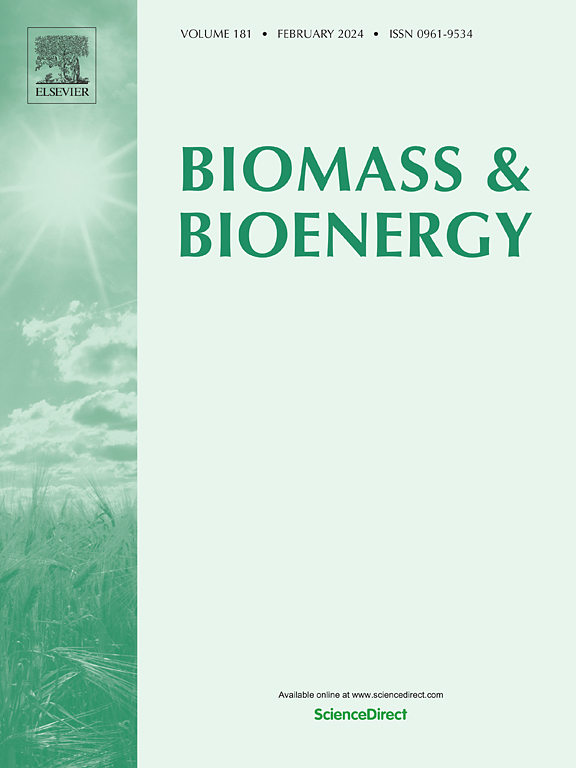Microwave-assisted pyrolysis of biomass: Influence of feedstock and pyrolysis parameters on porous biochar properties
IF 5.8
2区 生物学
Q1 AGRICULTURAL ENGINEERING
引用次数: 0
Abstract
Pyrolysis of biomass produces syngas, bio-oil and biochar, among which biochar requires low pyrolysis temperature and it usually has good adsorption ability due to its complex porous structures. In this study, microwave-assisted pyrolysis of different kinds of biomass such as rice husk, peanut shell, and corn straw to produce biochar was investigated. The yields, specific surface areas (SSA), average pore diameters, and total pore volumes of biochars produced at different pyrolysis temperatures (700, 750, 800, 850, and 900 °C), microwave powers (400, 450, 500, 550, and 600 W), and residence times (60, 90, 120, 150, and 180 min) were detailed. The biochar yields ranged in 30.76–43.28 wt%, 25.71–38.93 wt%, and 23.71–36.95 wt% for peanut shell, rice husk, and corn straw, respectively. With increase in pyrolysis temperature, microwave power or/and residence time, the yield of biochar decreased gradually and eventually became stable, while the SSA of 4.68–323.33 m2/g and total pore volume of 0.0085–0.2015 cc/g rose monotonously, and the average pore size of 2.19–16.55 nm decreased monotonously. The maximum SSA of 323.33 m2/g occurred at 900 °C, 500 W, and 120 min for corn straw. The proposed correlations for biochar pore structures and pyrolysis conditions will provide guidance for porous biochar production from biomass. Porous biochar can be widely used in soil remediation, environmental pollution control, high-performance catalyst/adsorbent research and development, etc. The accurate preparation of biochar with appropriate pore structure is of great significance to promote the efficient recovery and utilization of biomass resources.

生物质微波辅助热解:原料和热解参数对多孔生物炭性质的影响
生物质热解产生合成气、生物油和生物炭,其中生物炭热解温度低,且由于其复杂的多孔结构,通常具有良好的吸附能力。本研究研究了微波辅助热解稻壳、花生壳、玉米秸秆等不同种类生物质制备生物炭。详细分析了不同热解温度(700、750、800、850和900℃)、微波功率(400、450、500、550和600 W)和停留时间(60、90、120、150和180 min)下生物炭的产率、比表面积(SSA)、平均孔径和总孔体积。花生壳、稻壳和玉米秸秆的生物炭产量分别为30.76 ~ 43.28 wt%、25.71 ~ 38.93 wt%和23.71 ~ 36.95 wt%。随着热解温度、微波功率和停留时间的增加,生物炭产率逐渐下降并趋于稳定,SSA (4.68 ~ 323.33 m2/g)和总孔体积(0.0085 ~ 0.2015 cc/g)单调上升,平均孔径(2.19 ~ 16.55 nm)单调减小。玉米秸秆在900°C、500 W、120 min时的最大SSA为323.33 m2/g。提出的生物炭孔隙结构与热解条件的相关性将为生物质制备多孔生物炭提供指导。多孔生物炭可广泛应用于土壤修复、环境污染治理、高性能催化剂/吸附剂研发等领域。准确制备具有合适孔隙结构的生物炭,对促进生物质资源的高效回收利用具有重要意义。
本文章由计算机程序翻译,如有差异,请以英文原文为准。
求助全文
约1分钟内获得全文
求助全文
来源期刊

Biomass & Bioenergy
工程技术-能源与燃料
CiteScore
11.50
自引率
3.30%
发文量
258
审稿时长
60 days
期刊介绍:
Biomass & Bioenergy is an international journal publishing original research papers and short communications, review articles and case studies on biological resources, chemical and biological processes, and biomass products for new renewable sources of energy and materials.
The scope of the journal extends to the environmental, management and economic aspects of biomass and bioenergy.
Key areas covered by the journal:
• Biomass: sources, energy crop production processes, genetic improvements, composition. Please note that research on these biomass subjects must be linked directly to bioenergy generation.
• Biological Residues: residues/rests from agricultural production, forestry and plantations (palm, sugar etc), processing industries, and municipal sources (MSW). Papers on the use of biomass residues through innovative processes/technological novelty and/or consideration of feedstock/system sustainability (or unsustainability) are welcomed. However waste treatment processes and pollution control or mitigation which are only tangentially related to bioenergy are not in the scope of the journal, as they are more suited to publications in the environmental arena. Papers that describe conventional waste streams (ie well described in existing literature) that do not empirically address ''new'' added value from the process are not suitable for submission to the journal.
• Bioenergy Processes: fermentations, thermochemical conversions, liquid and gaseous fuels, and petrochemical substitutes
• Bioenergy Utilization: direct combustion, gasification, electricity production, chemical processes, and by-product remediation
• Biomass and the Environment: carbon cycle, the net energy efficiency of bioenergy systems, assessment of sustainability, and biodiversity issues.
 求助内容:
求助内容: 应助结果提醒方式:
应助结果提醒方式:


